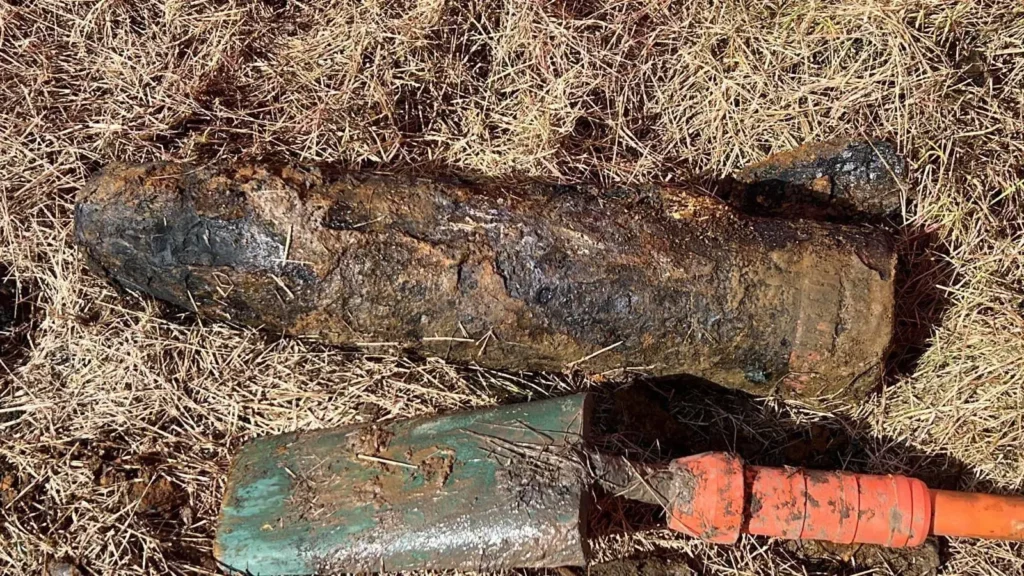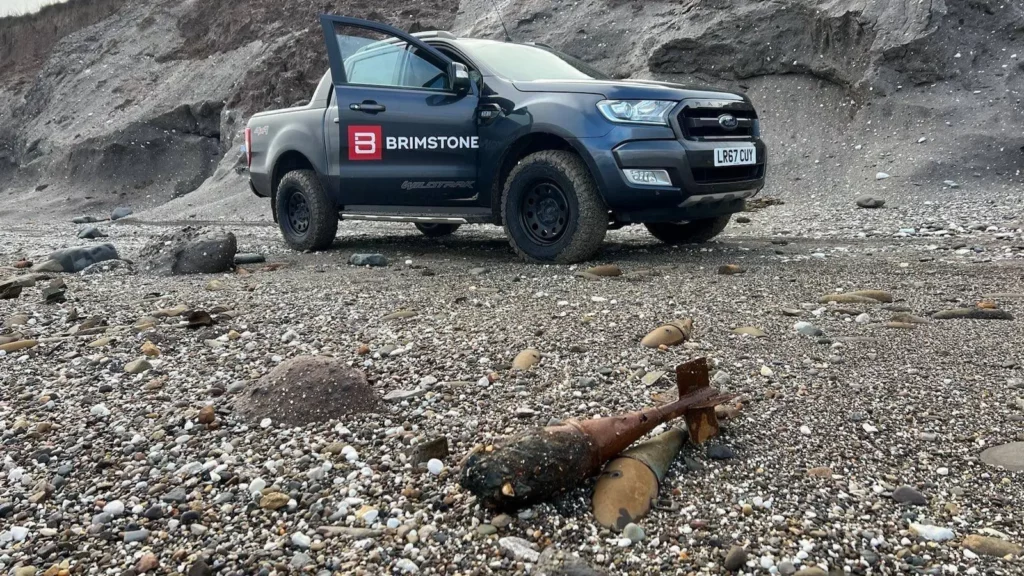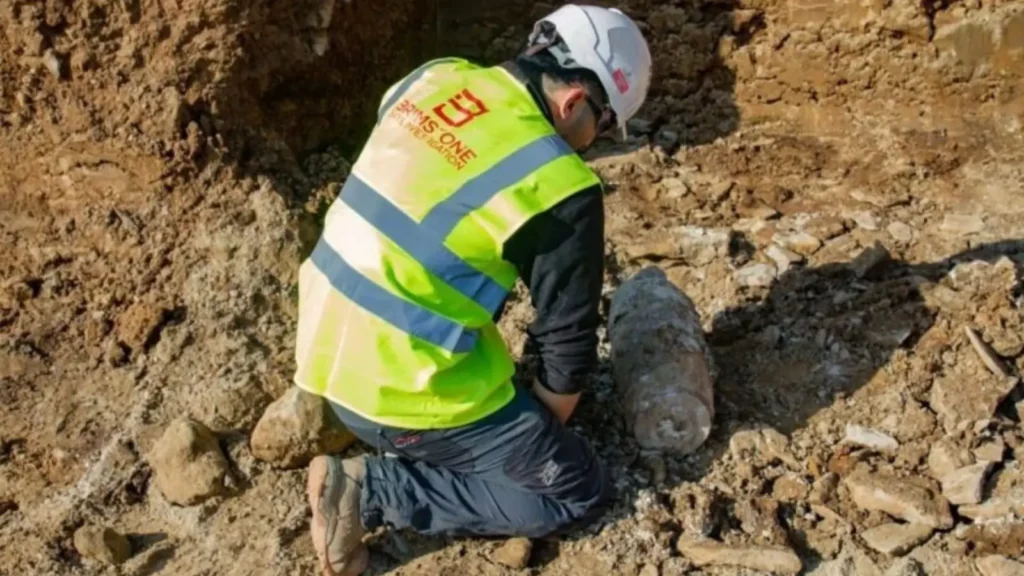What is Unexploded Ordnance (UXO)?
What is unexploded ordnance (UXO)?
Unexploded ordnance, or UXO as it’s commonly known, is explosive ordnance which has been primed, fused, armed or otherwise prepared for action and which has been buried, dropped, fired, launched, projected, thrown, or placed in such a manner as to constitute a hazard to material, installations, operations, or personnel. It remains unexploded either by design, malfunction or for any other cause.
Items of UXO are sometimes referred to as unexploded bombs (UXB) or explosive remnants of war (ERW).
Why is there UXO contamination in the UK?
In the UK, UXO contamination comes from a range of sources. During World War 1 and World War 2, the UK was heavily bombed by the Luftwaffe (German Air Force), resulting in large quantities of unexploded bombs scattered across the country. Some of the most densely bombed cities included Birmingham, Bristol, Coventry, Exeter, Glasgow, Liverpool, London, Plymouth, Southampton and Portsmouth, with the areas most at risk from being bombed being docks, airfields, major cities, manufacturing sites and industrial centres.
In 1937, the Air Raid Wardens Service was established. They were responsible for reporting incidents, extinguishing small fires and investigating reports of unexploded bombs. Despite their best efforts to identify the presence of UXO following an air raid, the damage caused by detonated bombs made it difficult, with many items of ordnance going undiscovered. Some of these unexploded bombs continue to pose a risk to the public today.
However, German bombs are not the only type of UXO found in the UK. During the war, we manufactured ordnance for our wartime activities abroad. Some of these items of ordnance were used in this country during military training. Munitions were regularly tested in live fire exercises, simulating a realistic combat environment. Therefore, munitions could have been deposited as part of military training. Alternatively, they may have been dumped deliberately, accidentally or disposed of ineffectively due to poor working practices. Royal Ordnance Factories (ROF) for example sometimes buried ordnance on site after the war.
After WW2, efforts were made to clear former training areas of UXO, but due to the technology not being as advanced as it is today, sometimes items were missed.
What does UXO look like?
UXO can range in size, from small arms ammunition to large, unexploded bombs weighing over 2000kg. It can come in many different shapes and sizes, can look old and rusty, or like new. It can be out in the open, partially visible, or buried underground. It may be fully intact or in fragments.
The fact that items of UXO aren’t a particular size or shape, and sometimes don’t look dangerous at all, contributes to what makes them so deadly.
For example, children in current and post-conflict communities are particularly vulnerable to these risks, as they can be attracted to remnants for their colourful appearance, unaware of how dangerous they are. Some items of ordnance look like familiar household objects that have been turned into explosives. In some countries, children collect scrap metal to sell, not knowing that they are carrying a deadly device. These are just some of the reasons why children account for roughly half of the casualties from explosive ordnance, as reported by UNICEF.
It is important to remember that the size or shape of UXO does not indicate its potential danger. Even small items of UXO can cause serious damage, injury or worse if handled incorrectly.

Is UXO dangerous?
Items of UXO can be extremely dangerous and should always be dealt with by explosive ordnance disposal (EOD) specialists. If disturbed, unexploded ordnance can detonate, causing damage to nearby infrastructure and seriously injuring or killing those in close vicinity.
Items of UXO degrade over time, becoming more volatile, however, they will not spontaneously explode. They require an external event to create the conditions for a detonation to occur. This could be a change in temperature, vibration or a direct impact, for example from piling or excavation works. In some cases, the clock timer in the fuse may be restarted if the item is disturbed by direct contact or vibration.
Unexploded ordnance can have a detrimental effect on communities, free movement, and construction projects long after a conflict has ended. So far nobody has been killed in the UK from a UXO incident, however, there have been several fatalities in Europe where construction workers and bomb disposal specialists have been seriously injured or killed by UXO-related incidents. One example of this was in 2014 when a construction worker in Germany was killed after a power shovel struck an unexploded WW2 bomb. Two others were also critically wounded in the incident.
Post-conflict communities also see regular UXO fatalities and serious injuries. Save the Children reported that a child in Yemen was killed or injured by landmines or other explosive devices every two days on average during 2022. Meanwhile, UNICEF reported that in Syria, landmines and unexploded ordnance were the leading cause of child casualties in 2021.
It’s not just human factors that should be considered when thinking about UXO risks, as unexploded ordnance can have devastating impacts on the environment too. Degrading ordnance can release harmful chemicals, contaminating soil and groundwater.
What about practice bombs?
There is a common misconception that practice bombs (sometimes called duds or dummy rounds) are not dangerous. This, however, is not true.
Practice ammunition often contains explosive substances. Even though this substance is a fraction of the size that would be used in fully operational items of ordnance, it can still be incredibly dangerous.
For example, RAF Cowden on the East Yorkshire coast was used as a combined artillery and field firing range from the 1940s through to 1998. It is thought that over 2.5 million items of ammunition were expended on the range during training exercises over the years. Today, Brimstone has a permanent presence on site, managing the UXO contamination on behalf of the MOD. We’ve found that 20% of the practice bombs contain phosphorus and are still live! If a member of the public took one of these items of UXO home, there is a risk of the item becoming unstable and detonating, causing serious damage.

What are some examples of UXO?
As previously mentioned, in the UK, UXO contamination can come from different sources including military training, ordnance manufacturing and storage, and enemy and Allied action in WW1 and WW2. These items of UXO are generally split into two categories:
- Air-delivered explosive ordnance
- Military/Allied explosive ordnance
Air-delivered explosive ordnance includes items dropped by the Luftwaffe during the Blitz. We know that many of these failed to explode, leaving a considerable danger buried beneath the surface:
- High explosive (HE) bombs were dropped in their thousands in WW2. Common variants include the 50kg, 250kg and 500kg bombs. There were also 1000kg and 1800kg bombs dropped, however, these were less common. These bombs easily penetrated the ground if they failed to explode. They had thick skin with a strong metal case that fragmented on detonation.
- Incendiary bombs were designed to cause fires and were used extensively in WW2, often in conjunction with HE bombs. They were dropped in containers, which would release the bombs at height, often distributing them over a wide area. Their design enabled them to split open and spill their contents on the surface rather than detonate, setting fire to targets. Some smaller variants had a delayed action charge aimed at injuring firefighters.
- Parachute mines, also known as aerial mines or ground mines, were adopted naval weapons that were deployed over land-based targets. There were two main variants, the Luftmine A which weighed 500kg and the Luftmine B which weighed 1000kg.
- Anti-personnel bombs contained small qualities of HE and had very little ground penetration ability. As a result, most of these would have been located in post-raid surveys and are therefore unlikely to be found today.
Military and Allied explosive ordnance includes items that have been fired, lost, dropped, buried or discarded, usually through training exercises or ordnance manufacturing:
- Rockets contain an explosive warhead, with the most commonly used type being anti-tank weapons. Today, these are unlikely to be found in urban areas but may be found on former training sites.
- Projectiles/Shells come in varying sizes and can be high explosive, shot (a solid projectile) or carrier. Again, they are likely to be found on former and current training sites, however, anti-aircraft artillery are sometimes found in urban areas from defence activities in WW2.
- Grenades are often cylindrical or canister-shaped, with old WW2 variants sometimes looking like miniature pineapples. These usually contain high explosives or smoke producing pyrotechnic compounds and were commonly initiated by a time delay. Again, these are likely to be found on training sites, however, they were used extensively by the Home Guard in WW2 so can be found in other areas too! The Home Guard was set up in 1940 as Britain’s ‘last line of defence’ against German invasion. Members were usually men unfit or ineligible for front-line military service or who were above or below the age of conscription. Due to the lack of available weapons and ammunition in 1940, they often improvised and made their own weapons, including ‘Sticky Bombs’ and ‘Self-Igniting Phosphorus Grenades’, also known as SIP Grenades. Once the war had finished, these were sometimes abandoned or forgotten about. There were an estimated 6 million SIP grenades produced by the Home Guard during WW2, and these are still found now and again across the country!
- Landmines come in two main forms, anti-tank mines and anti-personnel mines. In WW2, they were laid along the east and south coast of England in anticipation of German invasion. While these minefields were cleared after the war, landmines are sometimes still found on beaches today.
- Small arms ammunition (SAA) are most commonly referred to as bullets or rounds. These were designed to be fired from rifles, machine guns or pistols. They are often considered to be low risk but they can still be dangerous when tampered with or burnt!
- Mortars are either high explosive or carrier (smoke, incendiary, or pyrotechnic). They are fuse-initiated, and most commonly found on former training grounds.
It is important to remember that UXO contamination isn’t just a land-based issue. Marine UXO also poses a serious risk to maritime security and human life. We’ve explored this topic previously on our blog, where we took an in-depth look at sea mines. The origins of sea mines can be traced back to the 14th century, and over the years have been used for a range of reasons including ship destruction, denying access to specific areas and confining enemy vessels.
It is also worth noting that UXO contamination looks different in countries around the world. Some countries may have to deal with ordnance such as cluster bombs or improvised explosive devices (IEDs) for example.
What are some common UXO acronyms?
As with many sectors, there are a wide range of acronyms used in the UXO sector, which you may come across from time to time. Some common acronyms include:
AA: Anti-Aircraft
ALARP: As Low As Reasonably Practicable
CPT: Cone Penetration Testing or Cone Penetrometer Testing
EOD: Explosive Ordnance Disposal
HE: High-Explosive
IB: Incendiary Bomb
LSA: Land Service Ammunition
SAA: Small Arms Ammunition
UXO: Unexploded Ordnance
If you want to take a deeper look at the acronyms and definitions you might come across when dealing with UXO, take a look at our UXO acronyms guide here.
What should you do if you find UXO?
If you encounter a suspicious item that you suspect may be UXO, you should always follow these steps:
- Do not touch, move, or disturb the item.
- Keep a safe distance from the item and ensure others do the same.
- Immediately report the location and description of the item to police or local authorities.
- Follow the guidance provided by professionals and evacuate the area if advised to do so.
Remember, it’s always better to be safe and take the correct precautions. After all, explosive ordnance is designed to explode!
What can be done to manage UXO risks?
Safe and effective unexploded ordnance management is crucial for ensuring public safety and minimising environmental impacts.
Surprisingly, there’s no UK legislation defining the steps you must take to check for UXO before beginning any construction or development work. However, there are legal obligations under the Health and Safety at Work Act 1974 and Construction Design and Management Regulations 2015 to ensure the health and safety of employees.
CIRIA C681, which we explored previously on our blog, is the industry standard for UXO risk mitigation in the UK and is followed by UXO companies such as Brimstone and those working in the construction industry. This industry guide focuses on the management of risk associated with UXO and has four key stages: Preliminary UXO Risk Assessment, Detailed UXO Risk Assessment, Risk Mitigation and Implementation.
Specialists UXO companies, like ourselves, exist to provide a range of UXO services which are vital in ensuring UXO risks are handled safely and appropriately. At Brimstone, we are proud to be the UK’s only government-assured UXO company, providing unsurpassed unexploded ordnance risk management services in the UK and overseas. Our EOD personnel are recruited from the British Army, Royal Navy and Royal Air Force, with their years of military experience equipping them to carry out first-class mitigation work. Our UXO services include UXO risk assessments, surveys, investigations and disposals. We also offer training in the form of the UK’s only online UXO awareness course and IMAS level 1 and 2 training.
If you are embarking on a new project or have an upcoming site that requires UXO support, please get in touch with our dedicated commercial team by calling 020 7117 2492 or by filling out a contact form. Our team will be more than happy to assist you.
You can keep up to date with Brimstone by following us on Facebook, Instagram, X (formerly known as Twitter), LinkedIn and YouTube.
